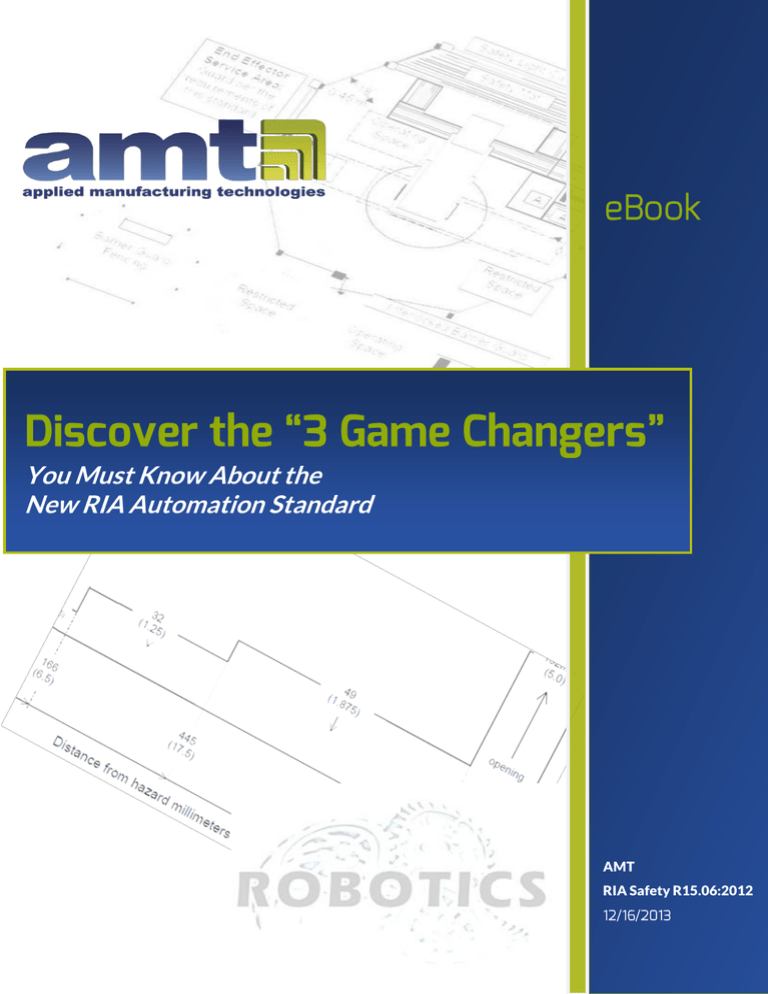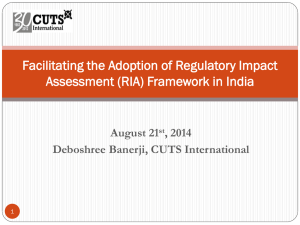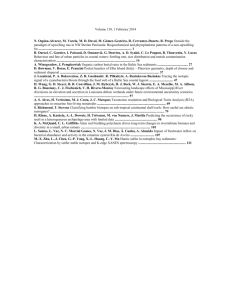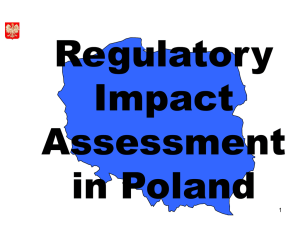
You Must Know About the
New RIA Automation Standard
AMT
RIA Safety R15.06:2012
Decoding the essentials of RIA R15.06:2012
The new Robotics Industry Association (RIA) standard for robots and robot
systems (RIA R15.06:2012) will have a significant impact on all businesses
using robotic automation.
Here is your guide to what you need to know about the most important parts of
the new safety requirements within the standard. These are the game changers
that promise to have the most relevance and effect on your robotics design,
construction, installation, operation, and maintenance.
What’s Inside:
The new RIA R15.06:2012 defined
The “3 Game Changers” revealed that will have the greatest impact
on business
How they can affect your business.
“Putting it all together” Solutions for compliance that you can
implement
At AMT, we are committed to providing our clients the information they need.
We are conversant with the new RIA standard and relevant U.S. and global
industrial automation safety standards. Whether you are an integrator or end
user, this guide is designed to help you begin navigating your way through the
new RIA standard in order to become compliant.
© 2013 Applied Manufacturing Technologies All rights reserved
Fourteen years after the previous RIA Safety Standard, a new set of guidelines has
recently been adopted. It will make automation systems even safer for workers. It
also addresses the technical advancement in robotic systems that have occurred
since RIA R15.06:1999, the previous version. A standard such as this is not a law;
however, we recommend full compliance with it. R15.06:2012 does not take full
effect until January 1, 2015. However, we recommend that starting now when
modifying or implementing new systems there is little advantage to use the previous
version.
A complete revision
According to the RIA document, the new R15.06:2012 Safety Standard is a “complete
revision” of the previous R15.06:1999 (r2009) Safety Standard.
Some of the most significant changes in the new standard include the following:
1. A total reorganization of the text presenting the ISO 10218-1 and ISO 10218-2
in their entirety. Both parts of the ISO documents are presented in one volume
R15.06.
2. Changes of selected terminology (e.g. reduced speed for slow speed, protective
stop for safety stop), but not changes to functional requirements
3. Additional requirements regarding new features offered on robots and the safe
integration of the features
4. Requirements for detachable and wireless pendants
5. Change in clearance requirements
6. The “Operator” applies to ALL persons performing tasks including maintenance
and repair
7. Requirements for collaborative robot operation (new feature)
8. Functional Safety– A change in requirements to define and quantify safety
control circuitry
9. Safety Rated Soft Limits (SRSL) - A change in the approved control of robot
motion to include newly developed safety-rated soft axis and space limiting
10. Mandatory Risk Assessment- A Risk Assessment SHALL be performed and is no
longer optional
The “game changers”
We have highlighted the last three of the changes noted above as true “game
changers”: we contend that these will have the most impact on your business in the
coming months in terms of cost impact, allocation of in-house resources, and required
personnel skill sets to execute the work.
Key Takeaway: Beginning January 1st 2015, new RIA safety standards take full effect,
including several changes that will significantly affect business by changing how robotic safety is
implemented in the U.S.
Robotic Industries Association
(RIA) is North America’s trade
group serving the robotics
industry. RIA now represents
more than 280 robot
manufacturers, system
integrators, component
suppliers, end user, consulting
firms, research groups, and
educational institutions. It hosts
the ANSI/RIA National Robot
Safety Standard and annual
National Robot Safety
Conference. www.robotics.org
As a RIA Certified
integrator AMT has
been identified as a
specialist in safety and
risk assessment saving
our clients valuable
time and costs from
the implementation of
the new standard
RIA Safety R15.06:2012
When adopting the new RIA standard, or any consensus standard, it is important to
understand the content of the standard as well as how the standard could affect you.
The industry leaders of the R15.06 Subcommittee worked diligently to identify
specific guidelines and responsibilities for safety of industrial robots and robotic
systems. Due to the complexity of the task and the language necessary to detail the
standard, it is helpful to have a guide to understand the intent of the standard. Our
goal in this eBook is to provide that guide and highlight the three areas that may have
the greatest impact.
These “3 Game Changers” are highlighted because of the potential impact that they
may have on your business. These are:
1. Functional Safety – A change in requirements to define and quantify safety
control circuitry
2. Safety Rated Soft Limits (SRSL) - A change in the approved control of robot
motion to include newly developed safety-rated soft axis and space limiting.
3. Mandatory Risk Assessment - A Risk Assessment SHALL be performed and
is no longer optional.
*This is a big shift for our industry, especially for system suppliers who are
already feeling the squeeze of tight budgets and timelines. It is paramount to
your business that you have a full understanding of how these game changers can
affect you.
New Robotic
Safety Standard
How they can affect your business
Require a change in the allocation of valuable time – Potentially taking time away
from other important tasks (size of change is process dependent)
Additional Resources required – Safety experts, operators, programming, controls,
maintenance etc.
Increased Liabilities – Without the proper implementation of the new standard,
there could be an increased liability.
Next, we will examine each of the highlighted RIA R15.06:2012 “3 game changers”
and explore a path to compliance.
Key Takeaway: The “3 Game changers” from the RIA safety standard demand
your attention because they can have a direct impact on your business operations.
RIA Safety R15.06:2012
The goal of implementing functional safety is to define, as well as quantify,
engineering solutions (safety measures, techniques and procedures) that need to be
implemented to achieve an acceptable safety hazard level in compliance with the
safety standard.
What RIA R15.06:2012 says:
Safety related parts of control systems shall be designed so that they comply with
PL=d with structure category 3 as described in ISO 13849-1:2006, or so that they
comply with SIL 2 with a hardware fault tolerance of 1 with a proof test interval of not
less than 20 years, as described in IEC 62061:2005.
– (Part 1), 5.4.2, Performance Requirements
In Other Words:
Supplied components and their integration into the safety-related control system
must meet the required safety performance level and have the life expectancy
needed to meet the system’s overall functional safety. Performance Level (PL, ISO
13849) or Safety Integrity Level (SIL, IEC 62061) are calculated metrics that result
from the analysis of the entire safety-related control system.
What it means to you:
First a risk assessment of the automation system is performed. The risk assessment
identifies potential system hazards. Then, with the findings of the risk assessment, a
Functional Safety Design (further engineering analysis) is conducted to identify the
methods to reduce risk to a level acceptable to the end user. These methods may
include system and/or operational changes. Some examples are physical guards,
safeguarding devices, awareness devices, safeguarding methods, control
components, operating practices.
To conduct a Functional Safety Analysis, engineers must identify or calculate each
independent component’s Functional Safety value. They must then coordinate the
accumulated value(s) of the safety system to meet an acceptable level of hazard
exposure. Some calculations to consider are:
1.
2.
3.
4.
5.
6.
PFHd = probability of dangerous failure per hour (IEC/EN 62061)
SIL CL = SIL claim limit (IEC/EN 62061)
MTTFd = Mean time to dangerous failure (ISO 13849)
DC = Diagnostic coverage (ISO 13839)
Category = resistance to fault (ISO 13849)
= Measure against common cause failure (ISO 13849)
The result of the analysis is a documented for many valuable future uses, such as
certification of a reliable safety system, system validation tool, and even a scope of
work document to be used through the implementation of the Functional Safety
System.
Key Takeaway: The new functional safety standard is highly technical and may
require special expertise in assessing the efficacy of safety control systems
“Functional Safety provides
validation of your risk
assessment
countermeasures to risk
reduction. Finally, we have
a tangible and quantifiable
way to determine if the
control system meets our
designed acceptable risk
levels as well as current
safety standards.”
Jean-Yves Chretien,
Certified TUV Functional
Safety Engineer
RIA Safety R15.06:2012
Historically, robotic safety and safeguarding was all about hardware-controlled limits
to a robot’s movements, combined with access restrictions to the potential motion
space. These limits took the form of physical hard stops on robot joints, structured
walls, and columns, limit switches mounted to the robot, and non-contact safety
devices. In order to keep hazards at a safe distance from operators, safeguarded
areas were much larger than was required for the productive functioning of the cell .
With the proper safety system design, the new standard will now allow us to
use less floor space!
What RIA R15.06:2012 says:
Soft limits are software-defined limits to robot motion. Space limiting is used to define
any geometric shape that may be used as an inclusionary or exclusionary zone, either
limiting robot motion within the design space, or preventing the robot from entering
the defined space.
– (Part 1) 5.12.3, Safety-rated Soft Axis and Space Limiting
Robot installations SHALL be designed and integrated so as to reduce the potential
exposure of personnel hazards.” “To reduce the safeguarded space, the maximum
space can be limited by the provision of integral or external devices that restrict the
movement of the robot system.
– (Part 2) 5.4.1, Limiting Robot Motion (General)
What it means to you:
The development of Safety Rated Soft Limits (SRSL) was a
major innovation by robot manufacturers. They are
programmable software-defined limits to robot motion
within the robot’s operating system.
SRSL’s deliver immense
flexibility compared to
traditional safety
limiting and can help
dramatically optimize
floor space while
adhering to the new
RIA standard
When ordering a “new” robot with the proper Safety Rated
Soft Limit and/or manufacturer hard stop options the system
can be programmed to use a smaller portion of the robot’s
maximum reach area. By doing so the restricted space can be reduced to closer
match the shape of the required work envelope. Thus, less perimeter safeguarding
can be used and the guarding will enclose less floor space.
Now that SRSL’s are safety-rated and accepted by national standards. This can be of
great benefit since it allows further optimization of floor space. Your overall robotic
system space requirements can be reduced by integrating the proper safeguard
devices into your safety control system.
Key Takeaway: The new RIA safety standard offers potential robotic system
implementation cost savings by reducing system components and reducing the amount of
floor space required
The figure above represents
a reduction in required floor
space using SRSL’s of a
system with the same work
envelope.
“With the new RIA safety
requirements and the ability
to purchase the
“SafeOperation” option on
our new robot, we were able
to save over 120 square foot
of productive floor space
within our cell. In granite
processing facilities, floor
space is at a premium and
this benefit will maximize
our material processing
area.” - Chuck Russo,
Owner Surface enCounters
RIA Safety R15.06:2012
A Risk Assessment is a comprehensive evaluation of the possible injury or damage to
health in a hazardous situation that is done in order to eliminate or reduce hazard or
to select appropriate safeguards.
The new standard now mandates that a Risk Assessment is the responsibility of all
involved in a robotic system’s build and use. It requires them to evaluate the hazards
associated with the robot system over its lifecycle. (i.e. commissioning set-up,
production, maintenance, repair, decommissioning.)
What RIA R15.06:2012 says:
Because a robot system is always integrated into a particular application, the
integrator SHALL perform a risk assessment to determine the risk reduction
measures required to adequately reduce the risk presented by the integrated
application.
– (Part 2), 4.3.1, Risk Assessment (General)
What it means to you:
Robotic systems must be assessed for risk. The assessment’s complexity varies with
the system’s application and use.
Previously, conducting a Risk Assessment was the end user’s responsibility. With RIA
R15.06:2012, a Risk Assessment must be done of all robotic systems by the system
supplier and the end user. Furthermore, a Risk Assessment is recommended on all
automation systems.
Ultimately, this process should be used to Identify, Assess, Reduce, and Verify that all
hazards are at an acceptable “Risk level” for operator interaction. To establish the
“risk level”, all hazards are required to be assessed according to their SEVERITY,
EXPOSURE, and AVOIDANCE. Based on these items, the following are BASIC steps
that should be used during a risk assessment.
1. Identify: All Risks, All Hazards, Who could be affected, probability of
occurrence and severity of the hazards)
2. Assess the risk: Use of the ANSI B11 TR:3 2000 chart is the best method to
describe the risk level
3. Reduce Risk to Acceptable: Create mitigation solutions that bring risks to a
level that are acceptable for the systems end user
4. Validation of the mitigation action taken: Validation that the implemented
hazard protection has appropriately reduced the potential harm, that all
safeguard solutions are properly working, and that all hazards will be
monitored and controlled through the lifecycle of the equipment
Key Takeaway: Mandatory risk assessments for robotic systems are now the
responsibility of the system supplier and the end user. This will require additional time and
resources from both the supplier and the end use.
RIA Safety R15.06:2012
Let’s recap;
The new RIA R15.06:2012 Safety Standard is now complete and this long awaited
set of revised guidelines has been adopted. This standard makes automation systems
safer for workers, and addresses the technical advancement in robotic systems.
An important question is, how does it affect you, your business and how are you going
to become compliant?
We identified what we consider the most impactful “3 Game Changers” in the new
standard:
1. Functional Safety
2. Safety Related Soft Limits (SRSL)
3. Mandatory Risk Assessment
To assure compliance with the new standard you will need to adhere to these
changes and possibly other changes and implement them into your future operations.
To do that there are a couple of solutions:
1. Implement from within – You can do it in-house with your current resources.
2. Outsource – Bring a company in to consult on solutions. This may include an
evaluation of your current operations, perform a Functional Safety design, or
to do a Risk Assessment.
When evaluating these options there are some factors you want to consider:
For new cells, if I change nothing, am I exposed to increased liability?
The short answer is…yes. OSHA is recommending that RIA R15.06:2012 be used as a
guideline. At a minimum, the RIA standard now requires a Risk Assessment.
Conducting a proper risk assessment will be crucial to your operation. If not properly
done, it can increase your liability
Will I have the time required?
Every process is different. Some assessments will require more time than others will.
Do you have the additional time? Can you afford the required time and resources to
complete the process?
Will I have the resources I need?
Do you have the in-house staff and knowledge needed to complete the compliance
process? Do you have a safety expert on staff?
RIA Safety R15.06:2012
If you have determined that you may not have the time, resources, or expertise to
fully comply with the new RIA standard, you may be considering outsourcing.
Consider this;
Some companies that provide consulting services also sell safety related hardware.
They may come with a product agenda that could include purchasing their products.
Make certain to verify credentials and seek out an RIA certified Robot integrator that
has the experience, expertise, and successful track record to partner with.
Introducing: The AMT Advantage
If you are interested in complying with the new RIA standard, AMT can consult with
you to find your best solution.
As an industry leader, AMT specializes in robotic challenges and solutions. We offer a
No Product Agenda approach to safety solution services. At AMT, we do not
manufacture safety related products. This allows us to take a product-neutral look at
your needs and design a solution tailored specifically for you. Whether it is a newly
installed or an existing system, we’ll recommend the hardware and software that best
suits your situation.
Among the benefits of using AMT for robotic system safety engineering:
AMT employs a certified Functional Safety Engineer and other consultants.
AMT has been assisting our customers with RIA specific risk assessments
for the past 6 years.
AMT is a RIA Certified Robot Integrator
By teaming up with AMT your company will benefit from our trained, certified
consultants who have the experience to identify possible hazards, determine risk
reduction requirements, and then propose and validate possible solutions.
Relying on AMT for advice and consultation during this period of change, you’re
assured of a minimum of disruption to your processes and in house resources.
Press Release:
The Robotic Industries
Association (RIA) today
announced that Applied
Manufacturing
Technologies (AMT) has
received the prestigious
RIA Certified Robot
Integrator designation. In
order to become certified,
AMT completed a rigorous
process that includes an onsite audit and testing of key
personnel among other
important criteria.
“We are delighted to
welcome AMT as
our eighteenth Certified
Robot Integrator,” said
Jeff Burnstein, President
of the RIA.
Learn how we can help you.
Timing is essential in the process and now is the time to get ahead of the competition.
Get your Personal Consultation Today!
Click Now To Get Started
(Ctrl + Click to open new window)
Our goal in this guide was to introduce you to the new RIA standards, shed some light
on what you can do to be compliant in 2014 and offer you the best possible solutions.
Proper implementation of the new RIA R15.06:2012 safety standard is crucial. With
knowledge, the right strategic partnership and careful implementation your business
can be safer and flourish in 2014 and many years beyond.
RIA Safety R15.06:2012
Applied Manufacturing Technologies
219 Kay Industrial Drive
Orion, MI 48359
248.409.2007
safety@appliedmfg.com
© 2013 Applied Manufacturing Technologies All rights reserved




